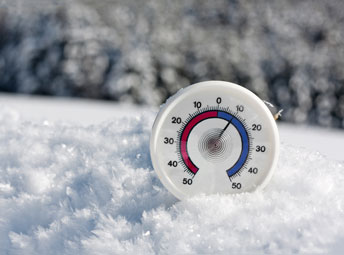 The weather is a fickle thing, and it’s always good to examine the effects it has on your materials and tools. In this article, let’s take a look at the effect of low temperatures on self-adhesive tape performance.
The weather is a fickle thing, and it’s always good to examine the effects it has on your materials and tools. In this article, let’s take a look at the effect of low temperatures on self-adhesive tape performance.
Self-adhesive tapes are commonly known as PSAs (Pressure-Sensitive Adhesives) and are available as single-sided or double-sided tapes. PSAs belong to the visco-elastic polymer group, which is an essential property for pressure-sensitive adhesives. Visco-elasticity pertains to a substance having both viscous and elastic properties.
The general rule is that the higher the temperature, the less force it takes to stretch a visco-elastic material. Conversely, the flexibility of the PSA polymers are reduced as the temperature decreases, causing the adhesive polymers to become harder and stiffer.
PSAs are sensitive to lower temperatures. Adhesion performance depends on the wet-ability of the adhesive. Wet-ability is linked to total surface coverage and describes the ability of the adhesive to achieve complete contact and coverage of two surfaces being bonded together. Lower temperatures decrease the flexibility of the adhesive polymers and, therefore, reduce the wet-ability. If the temperature gets very low, the adhesive becomes brittle and produces no stickiness. At this point, the polymer reacts like glass.
There are distinct differences within the various kinds of adhesive formulations. Natural rubber-based adhesives generally perform very well at lower temperatures. Acrylic adhesives also perform well, although caution is necessary. Cross-linking or curing leads to reduced flexibility of the polymer, which decreases the wet-ability and application at lower temperatures.
The backing of the adhesive also plays a crucial role in low-temperature performance. Unplasticized backings become stiffer at lower temperatures, compared to plasticized backings. Cloth backings remain flexible and conformable, even at very low temperatures, making them favorable for cold-temperature applications. ([I]Note:[I\] The adhesive is a critical component in pressure-sensitive tapes. As a general rule, a higher adhesive coating on the tape backing is better for cold-weather performance.)
The recommended temperature for applying a PSA to a substrate is between 59- 95°F. Within this temperature range, the combination of viscous and elastic characteristics of the PSA is well balanced, allowing the best surface wetting to be achieved. This temperature range applies not only to the tape, but also to the substrate. Once the tape is bonded to the substrate, the temperature range in which the applied tape can be used is much greater.
 An important factor regarding PSAs in cold environments is the tape application itself. One major consideration is to understand the amount of stresses that are present at the time of initial tape application. If there is slow stress, the polymer chains have the ability to react to the stress and absorb the tension. If stress is initiated very quickly, causing shock, the polymer chains have no chance to react to the stress and the assembly will fall apart.
An important factor regarding PSAs in cold environments is the tape application itself. One major consideration is to understand the amount of stresses that are present at the time of initial tape application. If there is slow stress, the polymer chains have the ability to react to the stress and absorb the tension. If stress is initiated very quickly, causing shock, the polymer chains have no chance to react to the stress and the assembly will fall apart.
tesa tape, Inc. is a developer of pressure-sensitive adhesive tape technologies. It recently introduced its tesa® ACXplus line of tapes specifically for the sign industry. For more, visit www.tesatape.com.











